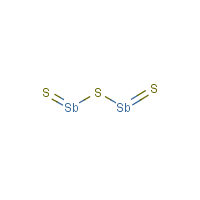Antimony trisulfide
Agent Name
Antimony trisulfide
CAS Number
1345-04-6
Formula
Sb2-S3
Major Category
Metals

Synonyms
Antimonous sulfide; Antimony Orange; Antimony sesquisulfide; Antimony sulfide; Antimony sulfide (Sb2S3); Antimony trisulfide colloid; Antimony vermilion; Antimony(3+) sulfide; Black antimony; C.I. 77060; C.I. Pigment Red 107; CI 77060; CI Pigment Red 107; Crimson antimony; Crimson antimony sulphide; Diantimony trisulfide; Lymphoscan; Needle antimony; Stibnite; [ChemIDplus] UN1549
Category
Metalloid Compounds (Antimony)
Description
Black solid (naturally occurring form, stibnite) or orange-red solid; [Hawley] If the unstable red-orange modification occurs along with the black, crystalline form, the mixture can be carmine or brownish red; [HSDB] Black odorless chunks; [MSDSonline]
Sources/Uses
Used in pyrotechnics, explosives, matches, and percussion caps; Also used to make ruby glass, vermilion (yellow pigment), antimony salts, camouflage paints, and veterinary medications; [HSDB] Potential exposure from glassblowing (antiquing); [www.ci.tucson.az.us/arthazards/medium.html]
Comments
Antimony compounds can cause injury to the liver, kidneys, heart, and lungs; [HSDB] "Sulfides of the heavy metals are generally insoluble and hence have little toxic action except through the liberation of hydrogen sulfide." [Sax] An irritant; [MSDSonline] See "Antimony" and linked occupational diseases.
Biomedical References
Exposure Assessment
TLV (ACGIH)
0.5 mg/m3, as Sb
PEL (OSHA)
0.5 mg/m3, as Sb
IDLH (NIOSH)
50 mg/m3, as Sb
Explanatory Notes
The Guide in the Emergency Response Guidebook is for "Antimony compound, inorganic, solid, n.o.s."
Adverse Effects
Hepatotoxin
Hepatoxic (a) from occupational exposure (secondary effect) or (b) in animal studies or in humans after ingestion
IARC Carcinogen
Probable (2a)
Diseases, Processes, and Activities Linked to This Agent
Processes
Industrial Processes with risk of exposure:
Activities
Activities with risk of exposure: